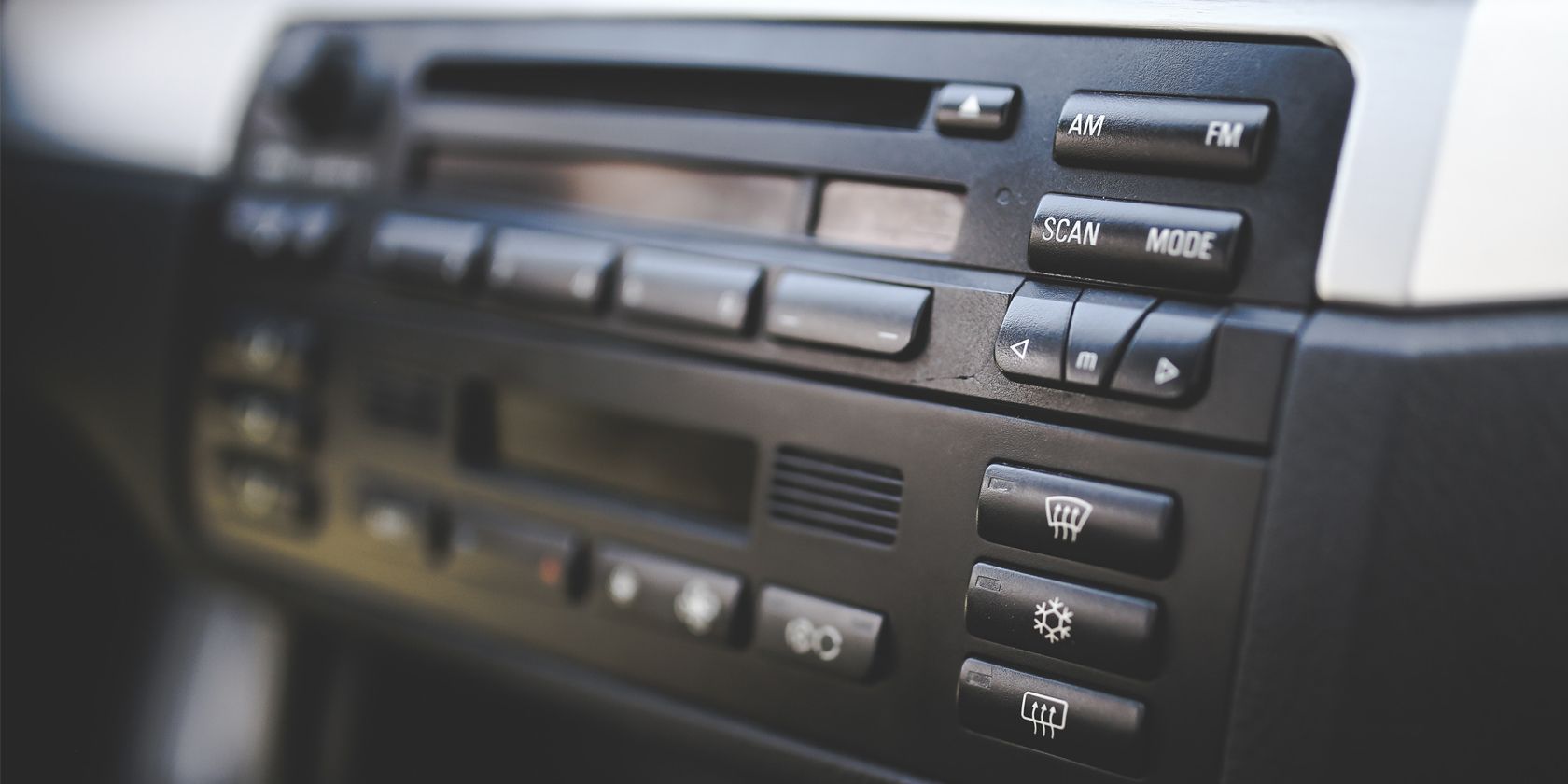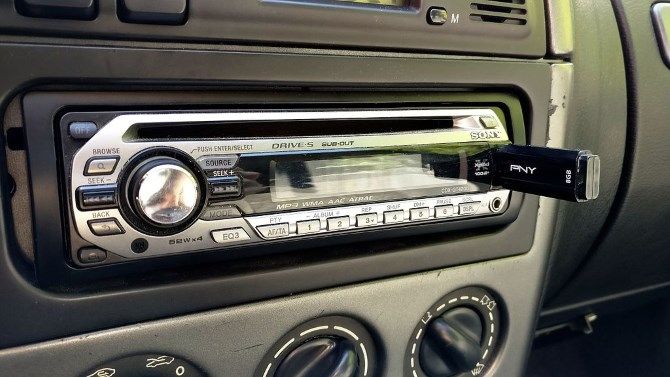With the variety of audio entertainment available on your phone, you'll want an easy way to enjoy your music, podcasts, audiobooks, and other content in your vehicle. But what's the best and easiest way to play music in your car from your device?
Let's explore your options for playing music from your phone to your car, no matter how old or new it is.
The Universal Option: Phone to Car Bluetooth FM Transmitters
Nearly every car has an FM radio and a cigarette lighter/power outlet, which you can combine to play your music using an FM transmitter. This is a great all-around option if your car doesn't have Bluetooth or an AUX port; the needed devices are relatively inexpensive and easy to set up. Keep in mind that this isn't the same as using FM transmitter apps on your phone.
The exact setup varies, but these transmitters usually plug into your car's outlet (or cigarette lighter in an older car) and connect to your phone via Bluetooth. After setting the device to broadcast on an unused FM station in your area, you can play your phone's audio through your car stereo by tuning it to that station.
However, depending on the number of FM stations in your area and the specific device you buy, audio quality may vary. And music doesn't sound as good through an FM transmitter as it does through using some of the other options here.
To clarify: it's not possible to play music through the cigarette lighter in your car alone. While FM adapters plug into this outlet, you can't play music directly through the lighter port.
Take a look at the best Bluetooth car adapters to find the right option for your needs.
For Reliability: Play Music Using an Auxiliary Cord
Most modern cars feature a 3.5mm auxiliary jack, either on the stereo unit or underneath it. This allows you to plug in a cable from your device's headphone port directly into your stereo. From there, simply play any audio on your phone that you'd like to hear through your car.
Auxiliary audio will sound clearer than an FM transmitter (or cassette adapter, as we'll see). However, the major downside is that this won't work unless your device has a 3.5mm headphone jack. These are increasingly rare on modern phones, and while you can get an adapter for your phone's charging port, some prevent you from charging while in use. But if both your car and phone have a stereo jack, it's a simple way to play audio without any fuss, as long as you don't mind a wire.
If you don't have an auxiliary cord yet, Anker's auxiliary audio cable should serve you well. Just remember that playing music through an AUX cord is not a "smart" method, so you'll have to change the track and make similar changes on your device. You can't use the controls on your car stereo or steering wheel with an auxiliary cord.
For Convenience: Play Music Over Bluetooth Audio
Even if you don't have an AUX port on your device, newer cars let you play music from your phone thanks to your car's built-in Bluetooth. Simply connect your phone to your car's Bluetooth like you would any other device (following the instructions in your vehicle's manual), and you can play media in the car from any apps you like. See our introduction to Bluetooth if you're not familiar.
Depending on your vehicle, you may be able to control the media using your car's buttons, plus see song information on its display.
Bluetooth is convenient because once paired, your phone will automatically connect to your car for easy streaming in the future. It also has the benefit of allowing hands-free calling, which doesn't work seamlessly with an auxiliary cable.
However, depending on your car, Bluetooth audio's quality may be inferior to what you get from an auxiliary cable. Try both methods to see which you prefer.
For Older Cars: Play Music Using a Cassette Adapter
If your car is old enough that it has a cassette player, you can make use of that for playing audio from your phone. Cassette adapters are basic devices, shaped like a cassette tape, that have an auxiliary audio cord on the outside.
You simply plug the adapter into your cassette player, then connect it to your phone via the attached 3.5mm auxiliary cable. Then play whatever you'd like from your phone, and you'll hear it through your car's stereo.
Reviews vary for these, but this Arsvita cassette adapter should work fine, and won't break the bank.
Compared to FM transmitters, cassette adapters don't have many advantages. Cassette audio quality isn't great, and you'll have an auxiliary wire hanging around your dash. And as mentioned, most phones these days don't have an AUX port, rendering this option impractical unless you also buy an adapter for your phone.
We only recommend using a cassette adapter if your cigarette lighter/power outlet doesn't work, or if you can't get a clear signal with an FM transmitter.
The Best of All Worlds: Play Music Through USB
Lots of cars now include a USB port, making this the most modern way to play music from your phone to your car. Having a USB port in your car allows you to charge your devices without an adapter, and you can even plug in a USB flash drive for music if you like. But you can also plug your phone in to play music directly.
If your vehicle has a USB port, using that is the best way to play audio to your car's stereo. Not only does it provide a reliable connection and clear audio, but it also charges your device and lets you make hands-free calls.
Of course, you'll need a spare USB cable for your car to do this. Depending on your phone, this could be an Apple Lightning cable, USB-C cable, or an older micro-USB cord. See our guide to USB cable types for help.
USB input is the only option that lets you play music from your phone to your car without any form of AUX or Bluetooth. It's also the only way to use a handy function of your phone that's built for playing music in the car, namely...
Play Music Using Android Auto and Apple CarPlay
A growing number of cars support Apple's CarPlay and Google's Android Auto functionality. These allow you to connect your phone to your car's head unit to conveniently access music, navigation, messaging, and more.
Not every car supports them, but if your car does, you should definitely take advantage of these features. Slick interfaces, as well as voice integration with Google Assistant and Siri, make them a joy to use. We've covered how to get started with Android Auto as well as how Apple CarPlay works.
Even if your car's infotainment unit doesn't support this, you can use Google Assistant driving mode, right on your Android phone's display. Combined with Bluetooth or a USB cable for audio, this setup offers nearly the same experience as having Android Auto on your head unit. CarPlay has no equivalent for this, unfortunately.
Some cars from 2020 and newer also support wireless Android Auto and CarPlay, allowing you to use these features without connecting a cable.
Upgrading to an Aftermarket Stereo Unit
We've only covered factory options and simple upgrades here. If you have an older car without built-in USB, Bluetooth, or auxiliary options, and don't want to use an FM transmitter or cassette adapter, you can replace your entire stereo unit. This will let you use modern functions like USB and Bluetooth connections—some even include Android Auto and CarPlay support.
Doing the replacement is a moderately intensive task, not to mention that it's more expensive than anything above. Thus, we don't recommend this unless you have some experience with that kind of work, and really don't want to use any of the above options.
If you're interested in this, Crutchfield is a great website to check out. It guides you through finding stereos that will fit your car, and every purchase includes a detailed setup guide.
What's the Best Option for Playing Music in Your Car?
The above options vary in audio quality and convenience. USB and auxiliary connections provide the best audio quality but aren't available on older car models, while cassette adapters and FM transmitters are the lowest quality but work with most cars.
Keep in mind that other factors can affect the quality of your phone's audio in your car. If you have an older car with lousy speakers, you probably won't be able to tell much difference between an auxiliary cable and an FM transmitter. The same goes if your car is especially loud, or if you drive in noisy areas.
That being said, from best to worst audio quality, we recommend the following methods for playing music in your car using your phone:
- If your car has a USB input, use that. Android Auto or Apple CarPlay support is even better if it's available in your vehicle.
- Without USB input, use Bluetooth or auxiliary based on your preferences for convenience and hands-free calling, and whether your phone has an AUX jack.
- If your car has no USB, auxiliary, or Bluetooth built-in, use an FM transmitter.
- Only use a cassette adapter if your power socket doesn't work or FM transmitters don't function reliably enough.
Start Enjoying Music From Your Phone in Your Car
We've covered how to play music from your phone to your car, with options for every phone and vehicle. Once you've gotten connected, all you have to do is start the music or other media you want on your phone and let the tunes roll. Just remember to keep your focus on the road while driving.
And remember that there are many useful apps for driving beyond music and navigation.



